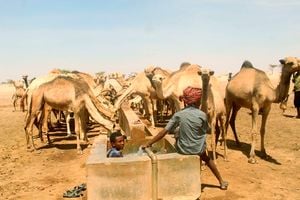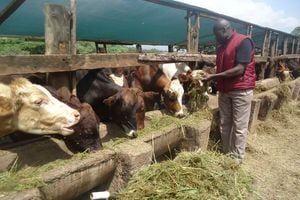
Thomas Onono, a livestock officer, feeds beef animals at Mazao Farm in Kisumu in 2015.
The issue reached a crescendo when leaders demanded to know why opponents of the programme were associating the vaccine with stopping cattle from 'farting'
Over the past few weeks, Kenyans have been engrossed with the issue of cattle and the discharge of methane into the environment. The matter was triggered by President William Ruto’s announcement on November 8 that the government planned a nationwide vaccination of 22 million cattle and 50 million goats to enhance global trade and improve incomes.
It was not clear what the animals would be vaccinated against, how often and for how long. To be fair, I would not expect such details from the President. They are technical matters that should be addressed by the Director of Veterinary Services (DVS).
Within no time, the issue was taken over by livestock health and production professionals, farmers, the public and politicians.
The ambiguity in the announcement, paucity of details and the fact that the President has given many promises that have not been fulfilled resulted in Kenyans interpreting the vaccination according to their interests, understanding and biases.
Kenya has become a nation of conspiracy theorists and armchair analysts. The country must seek to return to the path of evidence-based analyses and logical hypotheses.
It is difficult for anyone to believe reports communicated by others unless one really knows the story behind the news.
That is not a good environment for socio-economic development as the nation spends a lot of time, effort and expenses arguing about non-issues or investigating the results of genuine investigations.
The announcement quickly turned into an acrimonious national argument.
Some said there are conspirators planning to inject livestock with genetically modified vaccines that would prevent them from belching methane or releasing it through farting.
It has morphed into a serious political contest for the government and what is left of the opposition. Civil society actors and netizens have not been left behind.
Dr Ruto has got mad at the issue to the extent of using unpresidential language. Supporters of the President like Oscar Sudi and Kimani Ichung’wah have also used dishonourable language.
The issue reached a crescendo at the Baringo Kimalel Goat Auction where leaders, including the President, wanted to know why opponents of the programme were associating the vaccine with stopping cows from “farting”.
Vaccination is a normal activity in veterinary services. It improves animal health, production, human health, trade and socio-economic status of farmers and traders in animal and livestock products.
However, the issue was introduced in a way that confused Kenyans.
The President erred by taking on a role that belongs to technocrats, leaving people short of information and confused.
The matter could have been handled well by the DVS announcing a well-planned vaccination where key stakeholders had been involved. The President could also have announced, but tell Kenyans the DVS would follow up on engagement.
My article is motivated by the many questions from Kenyans to explain the hazy methane emission by cattle, climate change and vaccination against methane production. It is a long and complex issue.
Cattle are special animals that consume feeds like grass, which humans cannot digest. Cattle can also eat many of the foods consumed by people.
The first category of feeds thus helps in reducing competition for food between cattle and humans.
Cattle turn grasses and other fibres into milk and meat that nourish people with protein, energy in fat and sugars, minerals and vitamins.
They also provide humans with clothing from leather.
In the process of converting fibres into useful nutrients for cattle and humans, cows generate a gas called methane in the rumen. Most of the gas is belched out but some leaves through the rectum.
This methane has become a conundrum for climate change scientists, animal welfare advocates and livestock production experts.
Methane is a powerful greenhouse gas that causes climate change by raising temperature. This is one of the main reasons some climate change advocacy groups do not like beef and dairy production.
However, there is respite because methane is a short-lived gas. It lasts and warms the atmosphere for about a decade before being broken down into carbon dioxide and water.
The carbon is then available to be utilised by plants for photosynthesis to grow and produce oxygen. Most creatures require oxygen to burn carbohydrates and produce energy.
Methane is produced by cattle and other ruminants. There are bacteria called methanogens in the ruminant stomach that actually digest fibres to give the animals energy. If methane is not formed and removed, the stomach would become highly acidic and kill the animal.
Research is ongoing to find ways of minimising methane formation in the ruminant stomach or capturing the gas and using it as fuel. Biogas used as domestic energy mainly contains methane.
Some researchers propose that methane production can be minimised in cattle by developing a vaccine that stops methanogen bacteria from producing the gas. Cattle and other ruminants would then be given the vaccine. This is still experimental work.
The question would, however, arise of how the cow would eliminate the hydrogen ions that would make the rumen acidic and cause digestive disorders and death of the animal.
Modifying the ruminant diets by feeding more grains has been shown to reduce methane production. This, ironically, brings in the issue of competition for food between cattle and humans.
In addition, ruminants cannot be fed predominantly on grains as they may die from lactic acidosis.
Vaccinating cattle against methane production is, therefore, still experimental and not a priority for Kenya or any other country.
The government needs to stop the noise on the stated vaccination by appropriately engaging key stakeholders and providing full disclosure on the programme without profiling Kenyans who question the real intention of the administration.











